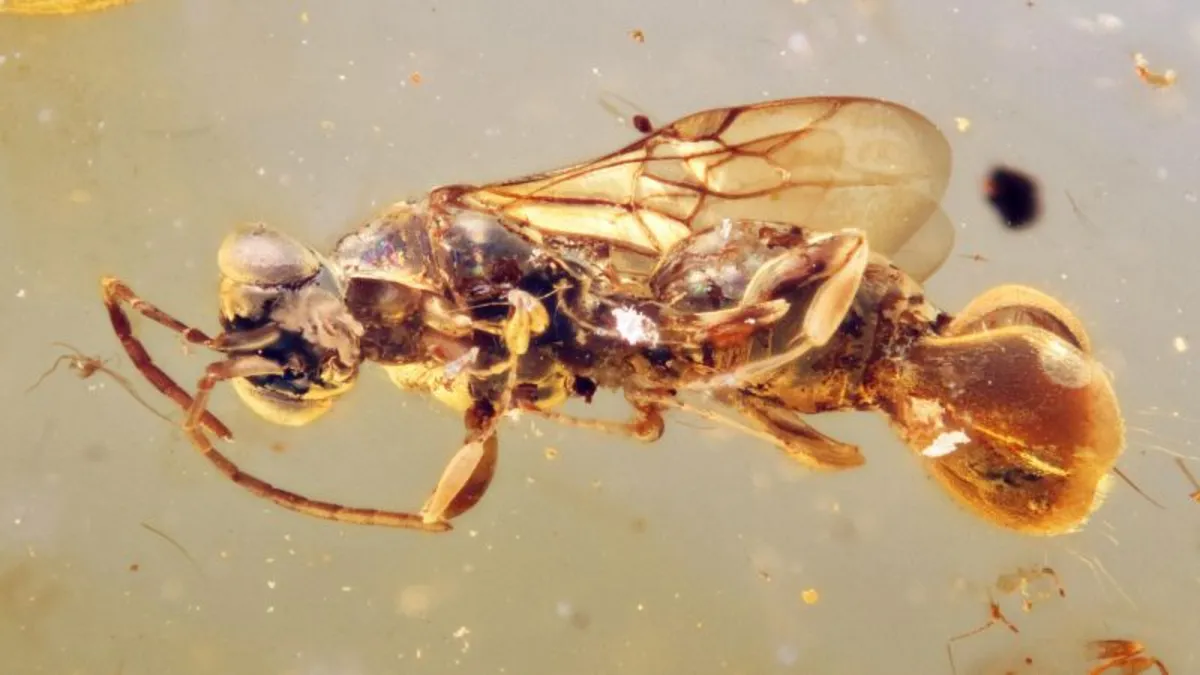
A groundbreaking study has unveiled a newly identified parasitic wasp that thrived among dinosaurs approximately 99 million years ago. This fascinating insect, named Sirenobethylus charybdis, showcases an extraordinary mechanism designed to capture other creatures, compelling them to serve as unknowing hosts for its young. The research, published in the journal BMC Biology, involved a detailed examination of 16 specimens of this tiny wasp, which were preserved in amber from the Cretaceous period, discovered in Myanmar.
Paleontologists noted that the wasp possessed a unique, Venus flytrap-like structure on its abdomen, enabling it to potentially trap other insects. Lars Vilhelmsen, a wasp expert and coauthor of the study, initially observed a peculiar expansion at the tip of the abdomen in the first specimen he examined. Initially mistaken for an air bubble, further investigation revealed that this feature was indeed part of the insect's anatomy.
Vilhelmsen and his colleagues from Capital Normal University in Beijing confirmed that this intriguing structure was movable, evident from its varying positions across different specimens. “Sometimes the lower flap, as we call it, is open, and sometimes it’s closed,” Vilhelmsen explained. This adaptability suggests that the structure was specifically designed for grasping prey.
The research team sought modern analogs to understand the function of this ancient wasp's anatomy. They discovered that the closest comparison could be drawn with the Venus flytrap, a carnivorous plant known for its hinged leaves that snap shut upon detecting prey. “There’s no way you can know how an insect that died 100 million years ago was living. So you look for analogs in modern insect fauna,” Vilhelmsen noted. However, no direct analogs were found among insects, prompting the researchers to look beyond the animal kingdom into the plant realm.
Interestingly, the study suggests that the wasp's grasping mechanism was not intended to kill its prey. Instead, researchers theorize that Sirenobethylus charybdis used this structure to inject its eggs into the bodies of trapped insects, which would then serve as hosts for the wasp's larvae. The larvae were likely to develop as parasites, eventually consuming their hosts.
Vilhelmsen indicated that the host insect was likely of a similar size to the wasp itself. This parasitic behavior is reminiscent of modern parasitoid wasps, such as cuckoo wasps, which lay their eggs in the nests of other wasp species, leading to the consumption of their hosts’ young.
Amber fossils provide a remarkable glimpse into the ancient world, preserving not only insects but also plants, flowers, and even remnants of dinosaurs. The amber containing Sirenobethylus charybdis was purchased by a fossil enthusiast from Myanmar’s Kachin region and later donated to Capital Normal University’s Key Laboratory of Insect Evolution and Environmental Changes in 2016. Despite the excitement surrounding amber fossils, ethical concerns have emerged regarding their sourcing, particularly following Myanmar's military coup in 2021.
Phil Barden, an associate professor at the New Jersey Institute of Technology, referred to Sirenobethylus charybdis as a “Cretaceous weirdo,” emphasizing the unusual adaptations of insects from that era. He noted that despite the existence of about a million known insect species today, many unexpected surprises remain hidden in the fossil record.
While Barden acknowledged the plausibility of the flytrap hypothesis, he also pointed out that further research is needed to fully understand the purpose of the wasp's unique abdominal structures. “Today, thousands of parasitoid wasp species are capable of immobilizing hosts without abdominal clasping,” he remarked, raising questions about the evolutionary advantages of such adaptations.
Vilhelmsen expressed his astonishment at the discovery, stating, “This is something unique, something I never expected to see, and something I couldn’t even imagine would be found.” The revelation of Sirenobethylus charybdis not only enhances our understanding of ancient insect behavior but also highlights the complexity of evolutionary adaptations in the natural world.